Chatbots were supposed to be the next breakthrough: what went wrong?
- Transfer
News publications spilled over: “In 2016, the transition to the bot paradigm will bring far more far-reaching and interesting consequences than the transition from the web to applications that took place in the past decade.”
Chatbots were Next In The Trend.
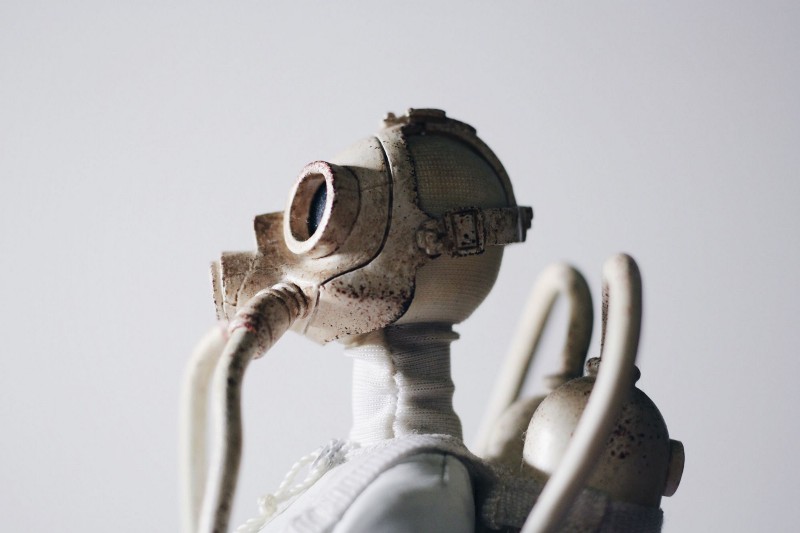
Our hopes soared in sky-high heights. The industry was looking forward to a new era of innovation with glowing eyes and a tail pipe: it's time to talk to machines. It seemed logical. All signs indicated insane success. Message exchange is at its peak! Interactive marketing has become a newfangled term! And WeChat! And China!
Moreover, it became obvious that in the market for these stupid applications with their laborious development, the offer greatly exceeds demand.
At the Mobile World Congress 2017, chat bots occupied all the front pages. The organizers of the conference referred to "universal agreement that in the future the attention of brands and corporations will inevitably shift to chat bots." In fact, the only serious question was who exactly monopolized the market; the fact that chatbots “take off” was beyond doubt:
A year later, we received the answer to this question: no. Because even the ecosystem itself, in which one could dominate, did not arise.

Chatbots are not the first technology that has been extolled to the skies and which subsequently significantly lost ground. Ancient as a world, the hype cycle has retained its usual course here.
Expectations grew and grew ... and then everything somehow blown away at once. The paradigm shift that everyone had predicted never happened. And the applications, which is characteristic, are still alive and well. Looking back at our choking optimism, we look at each other with some bewilderment: “Is that all? Was that the promised revolution? ”
Digan Ethan Bloch expressed the general sentiment like this:
According to Dave Feldman, vice director of product design at Heap, chat bots didn’t just take on a difficult task and didn’t extend it, they took on several difficult tasks at once and couldn’t do a single one.
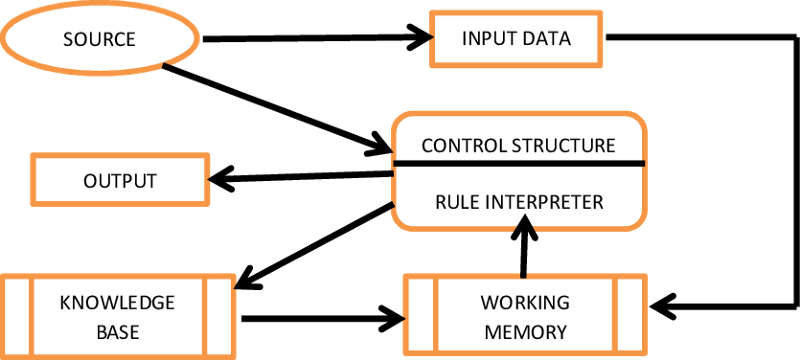
Bots can interact with users in many ways. The main contrast here is text and speech. In the beginning (era of computer interfaces) there was a (printed) word. Users had to drive commands into the machine manually in order to achieve anything from it.
Then the graphical interfaces arrived and saved everyone. They fascinated us with windows, mouse clicks and icons. Why, after a while all this even became colored!
Meanwhile, an army of researchers worked tirelessly to implement natural language into interfaces so that people no longer had to learn the puzzle language of database queries. Another army was developing speech recognition software so that you could just talk to your computer without having to type. It turned out to be much more complicated than it seemed to everyone at the beginning. A lot of accents, people who chatter or stretch words, slurred murmurs, all sorts of "mmmm" and "uhhhhh ..." How did you say, "recognize speech" or "just break the stove"?
The next point in the plan was to maintain a two-way dialogue with the machine. Here is an example of a possible dialogue (originally from the 90s) with a VCR setup system :
User: Good afternoon.
Agent: Good afternoon, what's your name?
User: Candy.
Agent: Hello Candy!
User: Let's set the clock.
Agent: What time is it now?
User: It's 11 a.m.
The agent sets the time: 11 hours.
Really cool? The system works with the user in a two-way mode and cleverly reads what is required of it. But she was carefully adapted to conversations related to the operation of the VCR, and functioned only within these well-defined frameworks.
Modern chat bots, both text and voice, face all of these difficulties, and plus they should be easy to scale and maintain efficiency on a wide range of platforms. In fact, we are still trying to achieve the same innovations as thirty years ago. It seems to me that the catch is in the following.
There was a bold assumption that "application time has passed" and they will be replaced by bots . Faced with these two significantly different concepts (instead of considering them as two separate entities created for different purposes), we ourselves created an obstacle to the development of bots.
Perhaps you still remember the similar battle cry that rang out ten years ago when applications were just starting to enter the market. But do you remember how applications supplanted the Internet?
It is said that a new product or technology must satisfy two of the three requirements: be better, cheaper, or faster. Are chatbots faster than apps? No - at least this is not the case at the moment. Whether they can be considered “better” is a moot point, but, in my opinion, today the highest-quality chat bot is much inferior to the highest-quality application.
In addition, no one seriously thinks that everything is too confusing at Lyft or that ordering food or buying clothes through the app is extremely difficult. What is really difficult is to try to perform these actions using the bot if the bot does not understand you.
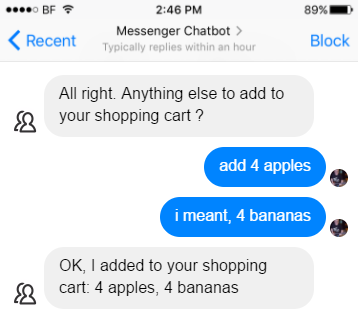
Clear. Add something else to your cart?
add 4 apples,
i.e. 4 bananas.
Well, I added 4 apples and 4 bananas to the basket.
The first-class bot is now as much use as the average application. If we talk about applications with rich, multi-layer, intricate functionality, they have nothing to oppose.
The reason lies in the fact that computers give us access to vast and complex information systems, and the first systems with a graphical interface were a revolutionary step in the development of these systems. Modern applications are built on the foundation of many years of research and experimentation. Why give up all this?
If instead of the word “replace” is put the word “supplement”, then everything becomes much more interesting. Today, the most successful experience is provided by those bots that adhere to a hybrid approach, embedding chat in a broader strategy that covers traditional elements.
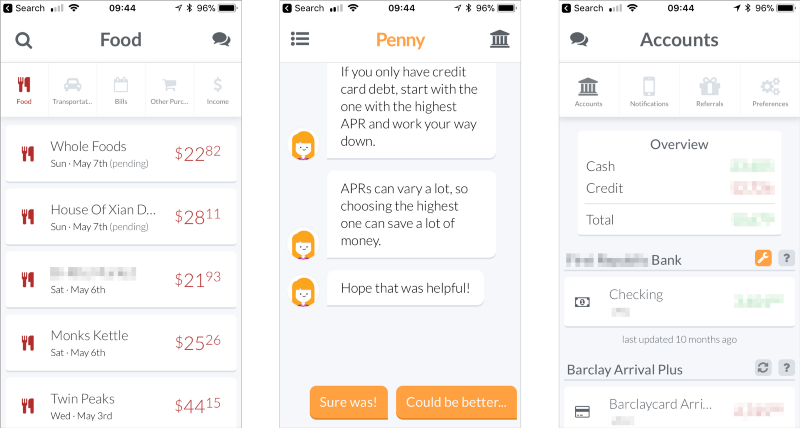
Penny talks to the user at ease, sending tips and notifications, but also provides a standard view of the control panel and the list of transactions.
HubSpot Conversations combines Facebook Messenger, local chat, social platform, email and other messaging systems - everything comes in a single box.
Layer gives developers tools to create a personalized messaging experience on mobile and desktop web applications and in native solutions.
The next wave will be applications with several mods : with them you can voice your request (like with Siri) and get an answer in different formats - in the form of a map, text or sounding speech.
Do I need a bot in my product? Are existing platforms capable of supporting its functionality? Do I have the patience to create a bot that will cope with the tasks that I set for it? Another negative aspect of the general enthusiasm is that under its influence, such issues usually bypass.
For many companies, bots are simply not the right solution. Over the past two years there have been many cases where they were used at random where they are not needed at all. If you make a bot just “so that it is”, give it complete freedom of action and hope for the best, it will definitely not end in anything good:
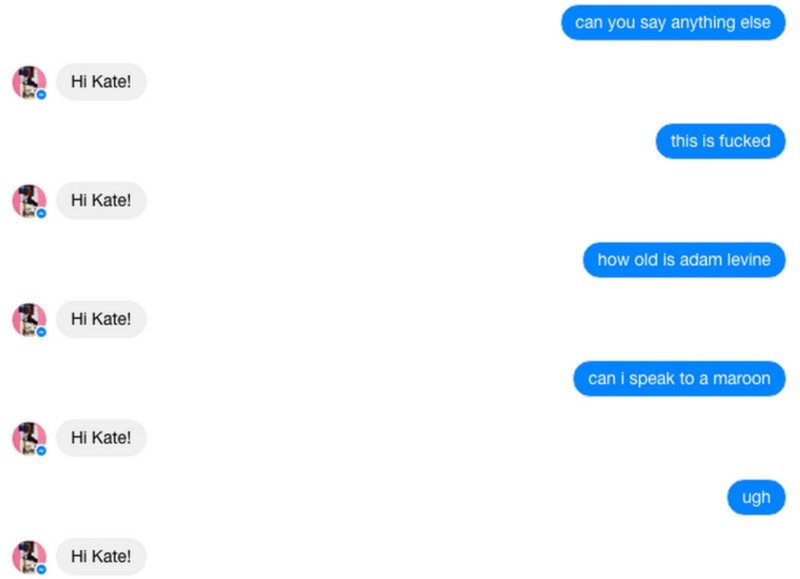
Chatbot Maroon 5 in action; I am sure that it was urgently needed.
The vast majority of bots use decision tree-based logic, which assumes that the bot will produce one of the prepared answers based on the keywords that it identifies in the entered text. The advantage of this approach is that compiling a complete list of scripts for which the bot is designed is quite simple. And this is also its main drawback.
That's because the bot is nothing more than a reflection of the abilities, zeal and patience of the person who created it, and how many user needs and possible replicas he managed to cover. Problems begin when reality refuses to fit into the given framework.

Please select an item from the list.
Show the main menu.
Please select an item from the list.
Show the previous options.
Please select an item from the list.
Back to all options.
Please select an item from the list.
Dumb Bot
According to the latest reports , 70% of the total number of bots on Facebook Messenger (over 100,000) cannot fulfill even the simplest user requests. This is partly due to the fact that the developers did not choose one narrow scope for bots to focus on it and strengthen it in every way. We are working on creating GrowhBot, we decided to take it to the needs of sales and marketing instead of the “on all issues” model, although the temptation to succumb to excitement and use the potential opportunities to the fullest was great.
Do not forget: a bot that does something ONE, but well, is many times more useful than a bot that performs many tasks, but somehow.
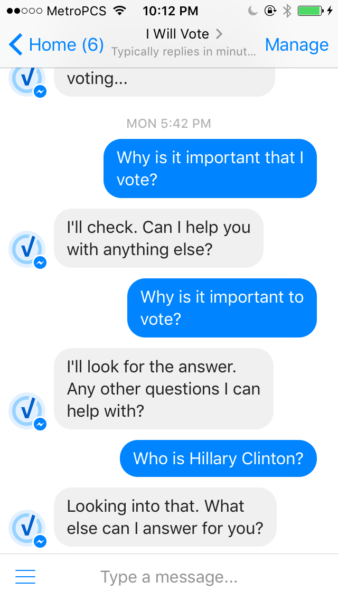
Why vote?
I will clarify. Can I help with something else?
Why vote?
I will look for an answer. Do you have any other questions?
Who is Hilary Clinton?
I am looking for information. Tell you something else?
A competent developer can create the most primitive chat bot in minutes - but if we talk about one that could support the conversation ... This is another story. No matter how much hype surrounding AI, in fact, we are still far from something remotely resembling human thinking.
In ideal reality, natural language processing technologies should allow the bot to understand the messages that are sent to it. But they are still in their infancy, they are just leaving research laboratories. Some platforms provide some kind of processing, but even the best samples are still presented in a very rudimentary form (as an example, you can recall Siri, who understands individual words, but not the general meaning that is embedded in them).
Matt Ezey outlines another related issue: they do not arouse the desire of developers to invest in them work and creative thinking:
Conversations have a complex structure, they are not linear. Topics overlap one another, change direction abruptly, suddenly end and pop up again after some time. Modern dialogue systems based on rulebooks are too fragile to cope with such unpredictability, and statistical approaches using machine learning also have serious limitations. The level of AI needed to simulate a conversation with a real person is now inaccessible.
At the same time, there are already individual examples of high-quality innovative bots that determine the development path for the rest. As Dave Feldman noted :
Once upon a time, communicating with computers was the only way - typing cryptic commands in the terminal. Visual interfaces where windows, icons or a mouse are used have become a real revolution in working with information. Computer science has switched from text interfaces to computer ones for some reason. If we talk about data entry, clicking faster than typing. Pressing a button or selecting from a list is clearly preferable to manually entering text, even with autocompletion (which often fails). If we talk about reading information, then seeing once, as a rule, is really better than reading a hundred times.
We like the visual presentation of information, because in principle we are very focused on visual perception. It is no coincidence that children love touchscreens so much.. The pioneers who came up with the idea of graphical interfaces were inspired by cognitive psychology and research on how our brains build communication.
Dialogue interfaces, according to the idea, should imitate the type of communication that is closest to people, but in reality they only increase the cognitive load. In fact, we are changing something very simple to a more complex alternative. Of course, we can express some ideas only in natural language (“show me all the options on how to get to the museum in 2000 steps, but within 35 minutes”), but most of the tasks in the GUI can be performed with greater efficiency and intuitive than using dialogue.
The desire to add the human dimension to business communication is quite logical. What is bad about sales and marketing right now is the feeling of human presence: brands are hiding behind numbered requests, feedback boxes, and e-mails marked "do not reply to this letter," automated mailing of replies and forms sending messages " one way".
Facebook set as its goal to create bots that would pass the so-called Turing test, that is, would be indistinguishable from the person in the dialogue. But a bot is still not a person, and it never will be.
Communicationincludes much more than just words. People can read between deadlines, extract information from context, and decrypt multilevel messages - for example, read sarcasm. Bots quickly forget what they are talking about - in the end, it seems as if you are trying to build a conversation with a person suffering from serious short-term memory impairments.
The HubSpot team made an exact point about this :
“Bots provide a way to communicate with customers individually, which can be easily applied on a large scale. However, they are not able to give people that pleasant, productive experience that conversations with other people in instant messengers, complicated in their semantic structure, bring. ”
It’s not so easy to fool people, so any attempt to pass off a bot as a person will have a bad effect on profit (not to mention cheating users is generally undesirable). Even those few bots that are built on the most advanced technologies do not reach this level.
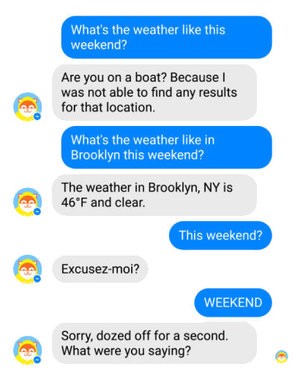
What will the weather be like on the weekend?
Are you in the boat? And then I can not find information on this location.
What will the weather be like over the weekend in Brooklyn?
In Brooklyn, New York, it's now 46 degrees Fahrenheit, clearly.
And on the weekend?
Sorry?
WEEKEND
Sorry, dozed off. What did you say?
And one moment. Dialogue interfaces tend to mimic the patterns that people prefer to follow in communication ... with other people. But do they want to build interaction with machines in the same way? Is not a fact.
Ultimately, no witty remarks and imitation of human behavior will save the bot from communicative failures.
In some ways, the early followers were still right. People really demand from Google Home to deliver their favorite song, order pizza from the Domino bot and learn to apply makeup under the direction of the Sephora bot. However, from the point of view of consumer reaction and developer activity, chat bots did not live up to the huge expectations that they had in 2015-2016. The real picture is not even near.
Computers are good at fulfilling their tasks: looking for information, making calculations, analyzing opinions and presenting all this data in a compact form. But computers are not capable of understanding human emotions. With the current state of processing technology, they don’t even understand what we want from, not to mention how we feel.
Therefore, it is still impossible to imagine effective user support without the participation of a person who would bring empathy and emotional intelligence. Today, bots can only help us with monotonous, mechanistic, low-level tasks, play the role of gears in a larger and more complex system. We hurt ourselves and them, demanding too much and not giving time.
But this is not the end of the whole story. Yes, our industry greatly overestimated the effect that bots will give initially. However, the key word here is “originally”. As Bill Gates once said:
The excitement has passed, and this is for the better. Now we can move from the stage of febrile exaggeration and black-and-white thinking to a moderate approach and a thorough study of the gray zone.
I believe that we are now approaching the stage of rapid growth . For technologies that bring about significant changes, this shift in climax is quite characteristic . Instant messaging will continue to gain popularity . Chat bots are not going anywhere . AI and natural language processing technologies are evolving every day . Developers, applications and platforms will continue to experiment with and invest in interactive marketing. And personally, I can’t wait to see what happens.
Chatbots were Next In The Trend.

Our hopes soared in sky-high heights. The industry was looking forward to a new era of innovation with glowing eyes and a tail pipe: it's time to talk to machines. It seemed logical. All signs indicated insane success. Message exchange is at its peak! Interactive marketing has become a newfangled term! And WeChat! And China!
Moreover, it became obvious that in the market for these stupid applications with their laborious development, the offer greatly exceeds demand.
At the Mobile World Congress 2017, chat bots occupied all the front pages. The organizers of the conference referred to "universal agreement that in the future the attention of brands and corporations will inevitably shift to chat bots." In fact, the only serious question was who exactly monopolized the market; the fact that chatbots “take off” was beyond doubt:
“Will there be a platform that will dominate the ecosystem of chat bots and personal assistants?”
A year later, we received the answer to this question: no. Because even the ecosystem itself, in which one could dominate, did not arise.
Deceiving Hype Cycle

Chatbots are not the first technology that has been extolled to the skies and which subsequently significantly lost ground. Ancient as a world, the hype cycle has retained its usual course here.
- Reverent articles written at TechCrunch
- Future-looking opinion leaders like Chris Messina have spoken
- In Silicon Valley, everyone was drooling from the looming opportunity to chat with smart computers
- Messenger flooded bots
- Slack went into rapid growth and even established a special fund for investment in the development of chat bots
Expectations grew and grew ... and then everything somehow blown away at once. The paradigm shift that everyone had predicted never happened. And the applications, which is characteristic, are still alive and well. Looking back at our choking optimism, we look at each other with some bewilderment: “Is that all? Was that the promised revolution? ”
Digan Ethan Bloch expressed the general sentiment like this:
“I don’t even know whether it is possible to talk about the death of chatbots, because I’m not sure if they were ever alive.”
According to Dave Feldman, vice director of product design at Heap, chat bots didn’t just take on a difficult task and didn’t extend it, they took on several difficult tasks at once and couldn’t do a single one.
Text vs. Speech vs. GUI: A Brief History

Bots can interact with users in many ways. The main contrast here is text and speech. In the beginning (era of computer interfaces) there was a (printed) word. Users had to drive commands into the machine manually in order to achieve anything from it.
Then the graphical interfaces arrived and saved everyone. They fascinated us with windows, mouse clicks and icons. Why, after a while all this even became colored!
Meanwhile, an army of researchers worked tirelessly to implement natural language into interfaces so that people no longer had to learn the puzzle language of database queries. Another army was developing speech recognition software so that you could just talk to your computer without having to type. It turned out to be much more complicated than it seemed to everyone at the beginning. A lot of accents, people who chatter or stretch words, slurred murmurs, all sorts of "mmmm" and "uhhhhh ..." How did you say, "recognize speech" or "just break the stove"?
The next point in the plan was to maintain a two-way dialogue with the machine. Here is an example of a possible dialogue (originally from the 90s) with a VCR setup system :
User: Good afternoon.
Agent: Good afternoon, what's your name?
User: Candy.
Agent: Hello Candy!
User: Let's set the clock.
Agent: What time is it now?
User: It's 11 a.m.
The agent sets the time: 11 hours.
Really cool? The system works with the user in a two-way mode and cleverly reads what is required of it. But she was carefully adapted to conversations related to the operation of the VCR, and functioned only within these well-defined frameworks.
Modern chat bots, both text and voice, face all of these difficulties, and plus they should be easy to scale and maintain efficiency on a wide range of platforms. In fact, we are still trying to achieve the same innovations as thirty years ago. It seems to me that the catch is in the following.
Opposition of applications and bots
There was a bold assumption that "application time has passed" and they will be replaced by bots . Faced with these two significantly different concepts (instead of considering them as two separate entities created for different purposes), we ourselves created an obstacle to the development of bots.
Perhaps you still remember the similar battle cry that rang out ten years ago when applications were just starting to enter the market. But do you remember how applications supplanted the Internet?
It is said that a new product or technology must satisfy two of the three requirements: be better, cheaper, or faster. Are chatbots faster than apps? No - at least this is not the case at the moment. Whether they can be considered “better” is a moot point, but, in my opinion, today the highest-quality chat bot is much inferior to the highest-quality application.
In addition, no one seriously thinks that everything is too confusing at Lyft or that ordering food or buying clothes through the app is extremely difficult. What is really difficult is to try to perform these actions using the bot if the bot does not understand you.

Clear. Add something else to your cart?
add 4 apples,
i.e. 4 bananas.
Well, I added 4 apples and 4 bananas to the basket.
The first-class bot is now as much use as the average application. If we talk about applications with rich, multi-layer, intricate functionality, they have nothing to oppose.
The reason lies in the fact that computers give us access to vast and complex information systems, and the first systems with a graphical interface were a revolutionary step in the development of these systems. Modern applications are built on the foundation of many years of research and experimentation. Why give up all this?
If instead of the word “replace” is put the word “supplement”, then everything becomes much more interesting. Today, the most successful experience is provided by those bots that adhere to a hybrid approach, embedding chat in a broader strategy that covers traditional elements.

Penny talks to the user at ease, sending tips and notifications, but also provides a standard view of the control panel and the list of transactions.
HubSpot Conversations combines Facebook Messenger, local chat, social platform, email and other messaging systems - everything comes in a single box.
Layer gives developers tools to create a personalized messaging experience on mobile and desktop web applications and in native solutions.
The next wave will be applications with several mods : with them you can voice your request (like with Siri) and get an answer in different formats - in the form of a map, text or sounding speech.
Bots for the sake of bots
Do I need a bot in my product? Are existing platforms capable of supporting its functionality? Do I have the patience to create a bot that will cope with the tasks that I set for it? Another negative aspect of the general enthusiasm is that under its influence, such issues usually bypass.
For many companies, bots are simply not the right solution. Over the past two years there have been many cases where they were used at random where they are not needed at all. If you make a bot just “so that it is”, give it complete freedom of action and hope for the best, it will definitely not end in anything good:

Chatbot Maroon 5 in action; I am sure that it was urgently needed.
The vast majority of bots use decision tree-based logic, which assumes that the bot will produce one of the prepared answers based on the keywords that it identifies in the entered text. The advantage of this approach is that compiling a complete list of scripts for which the bot is designed is quite simple. And this is also its main drawback.
That's because the bot is nothing more than a reflection of the abilities, zeal and patience of the person who created it, and how many user needs and possible replicas he managed to cover. Problems begin when reality refuses to fit into the given framework.

Please select an item from the list.
Show the main menu.
Please select an item from the list.
Show the previous options.
Please select an item from the list.
Back to all options.
Please select an item from the list.
Dumb Bot
According to the latest reports , 70% of the total number of bots on Facebook Messenger (over 100,000) cannot fulfill even the simplest user requests. This is partly due to the fact that the developers did not choose one narrow scope for bots to focus on it and strengthen it in every way. We are working on creating GrowhBot, we decided to take it to the needs of sales and marketing instead of the “on all issues” model, although the temptation to succumb to excitement and use the potential opportunities to the fullest was great.
Do not forget: a bot that does something ONE, but well, is many times more useful than a bot that performs many tasks, but somehow.
Low availability

Why vote?
I will clarify. Can I help with something else?
Why vote?
I will look for an answer. Do you have any other questions?
Who is Hilary Clinton?
I am looking for information. Tell you something else?
A competent developer can create the most primitive chat bot in minutes - but if we talk about one that could support the conversation ... This is another story. No matter how much hype surrounding AI, in fact, we are still far from something remotely resembling human thinking.
In ideal reality, natural language processing technologies should allow the bot to understand the messages that are sent to it. But they are still in their infancy, they are just leaving research laboratories. Some platforms provide some kind of processing, but even the best samples are still presented in a very rudimentary form (as an example, you can recall Siri, who understands individual words, but not the general meaning that is embedded in them).
Matt Ezey outlines another related issue: they do not arouse the desire of developers to invest in them work and creative thinking:
“We had no chance to arouse the interest of consumers, while artificial intelligence had not yet reached the level of humanity. The interest of users will be attracted by those AI technologies that will make bots really suitable for communication. ”
Conversations have a complex structure, they are not linear. Topics overlap one another, change direction abruptly, suddenly end and pop up again after some time. Modern dialogue systems based on rulebooks are too fragile to cope with such unpredictability, and statistical approaches using machine learning also have serious limitations. The level of AI needed to simulate a conversation with a real person is now inaccessible.
At the same time, there are already individual examples of high-quality innovative bots that determine the development path for the rest. As Dave Feldman noted :
“Should Slack, Facebook, Google, Microsoft, Kik and others create their own built-in bots that developers could focus on? Should they have been more active in establishing foundations and incubators, hiring mentors who could transfer knowledge to participants who entered the Bot Way, and providing engineering and design resources? Should they invest in Bot Strategic Initiatives and bring researchers together with well-known partners?
My answer is yes and yes. Speaking about platforms, developers are essentially the same users. And we do not allow users to figure out how and why to use our product themselves. They need to demonstrate it. ”
Graphical interfaces should not be neglected
Once upon a time, communicating with computers was the only way - typing cryptic commands in the terminal. Visual interfaces where windows, icons or a mouse are used have become a real revolution in working with information. Computer science has switched from text interfaces to computer ones for some reason. If we talk about data entry, clicking faster than typing. Pressing a button or selecting from a list is clearly preferable to manually entering text, even with autocompletion (which often fails). If we talk about reading information, then seeing once, as a rule, is really better than reading a hundred times.
We like the visual presentation of information, because in principle we are very focused on visual perception. It is no coincidence that children love touchscreens so much.. The pioneers who came up with the idea of graphical interfaces were inspired by cognitive psychology and research on how our brains build communication.
Dialogue interfaces, according to the idea, should imitate the type of communication that is closest to people, but in reality they only increase the cognitive load. In fact, we are changing something very simple to a more complex alternative. Of course, we can express some ideas only in natural language (“show me all the options on how to get to the museum in 2000 steps, but within 35 minutes”), but most of the tasks in the GUI can be performed with greater efficiency and intuitive than using dialogue.
People prefer to communicate with people.
The desire to add the human dimension to business communication is quite logical. What is bad about sales and marketing right now is the feeling of human presence: brands are hiding behind numbered requests, feedback boxes, and e-mails marked "do not reply to this letter," automated mailing of replies and forms sending messages " one way".
Facebook set as its goal to create bots that would pass the so-called Turing test, that is, would be indistinguishable from the person in the dialogue. But a bot is still not a person, and it never will be.
Communicationincludes much more than just words. People can read between deadlines, extract information from context, and decrypt multilevel messages - for example, read sarcasm. Bots quickly forget what they are talking about - in the end, it seems as if you are trying to build a conversation with a person suffering from serious short-term memory impairments.
The HubSpot team made an exact point about this :
“Bots provide a way to communicate with customers individually, which can be easily applied on a large scale. However, they are not able to give people that pleasant, productive experience that conversations with other people in instant messengers, complicated in their semantic structure, bring. ”
It’s not so easy to fool people, so any attempt to pass off a bot as a person will have a bad effect on profit (not to mention cheating users is generally undesirable). Even those few bots that are built on the most advanced technologies do not reach this level.

What will the weather be like on the weekend?
Are you in the boat? And then I can not find information on this location.
What will the weather be like over the weekend in Brooklyn?
In Brooklyn, New York, it's now 46 degrees Fahrenheit, clearly.
And on the weekend?
Sorry?
WEEKEND
Sorry, dozed off. What did you say?
And one moment. Dialogue interfaces tend to mimic the patterns that people prefer to follow in communication ... with other people. But do they want to build interaction with machines in the same way? Is not a fact.
Ultimately, no witty remarks and imitation of human behavior will save the bot from communicative failures.
Where do we go next?
In some ways, the early followers were still right. People really demand from Google Home to deliver their favorite song, order pizza from the Domino bot and learn to apply makeup under the direction of the Sephora bot. However, from the point of view of consumer reaction and developer activity, chat bots did not live up to the huge expectations that they had in 2015-2016. The real picture is not even near.
Computers are good at fulfilling their tasks: looking for information, making calculations, analyzing opinions and presenting all this data in a compact form. But computers are not capable of understanding human emotions. With the current state of processing technology, they don’t even understand what we want from, not to mention how we feel.
Therefore, it is still impossible to imagine effective user support without the participation of a person who would bring empathy and emotional intelligence. Today, bots can only help us with monotonous, mechanistic, low-level tasks, play the role of gears in a larger and more complex system. We hurt ourselves and them, demanding too much and not giving time.
But this is not the end of the whole story. Yes, our industry greatly overestimated the effect that bots will give initially. However, the key word here is “originally”. As Bill Gates once said:
“We always overestimate the scale of the changes that will occur in the next two years, and underestimate the scale of the changes that will occur in the next ten years. Do not let the calm lure you, be active. ”
The excitement has passed, and this is for the better. Now we can move from the stage of febrile exaggeration and black-and-white thinking to a moderate approach and a thorough study of the gray zone.
I believe that we are now approaching the stage of rapid growth . For technologies that bring about significant changes, this shift in climax is quite characteristic . Instant messaging will continue to gain popularity . Chat bots are not going anywhere . AI and natural language processing technologies are evolving every day . Developers, applications and platforms will continue to experiment with and invest in interactive marketing. And personally, I can’t wait to see what happens.
